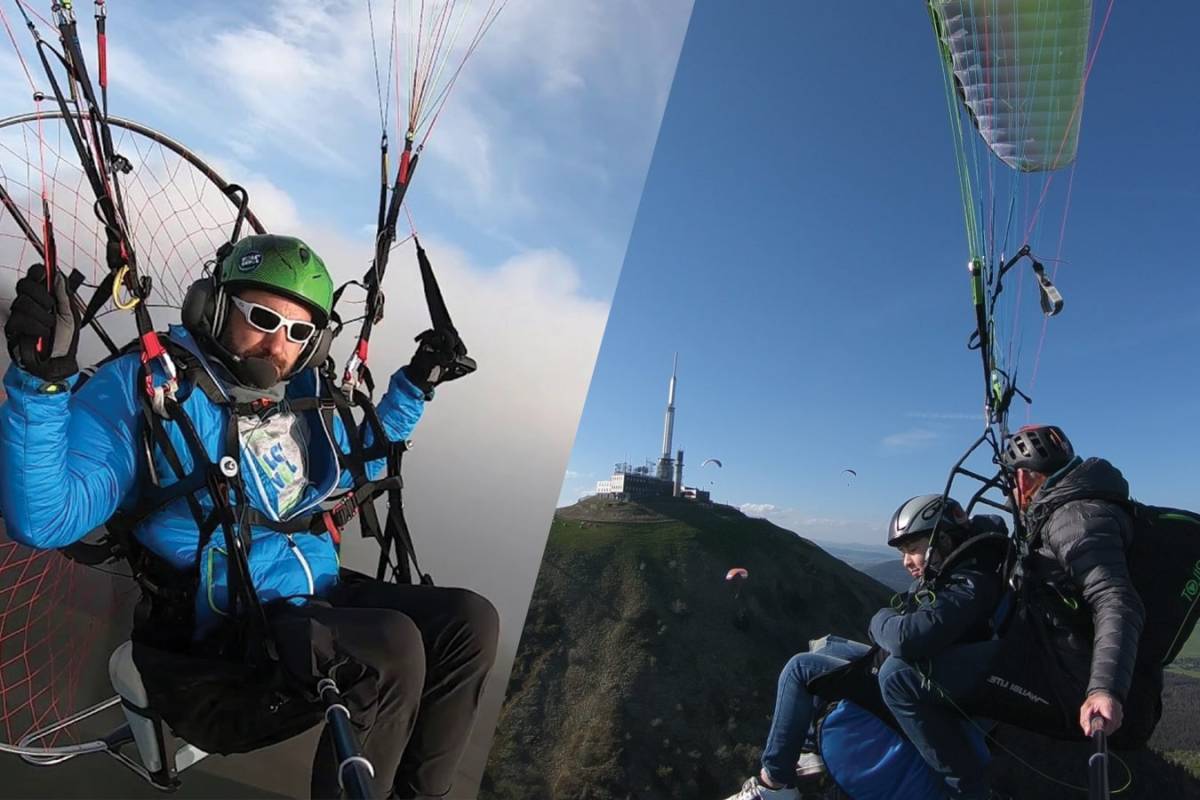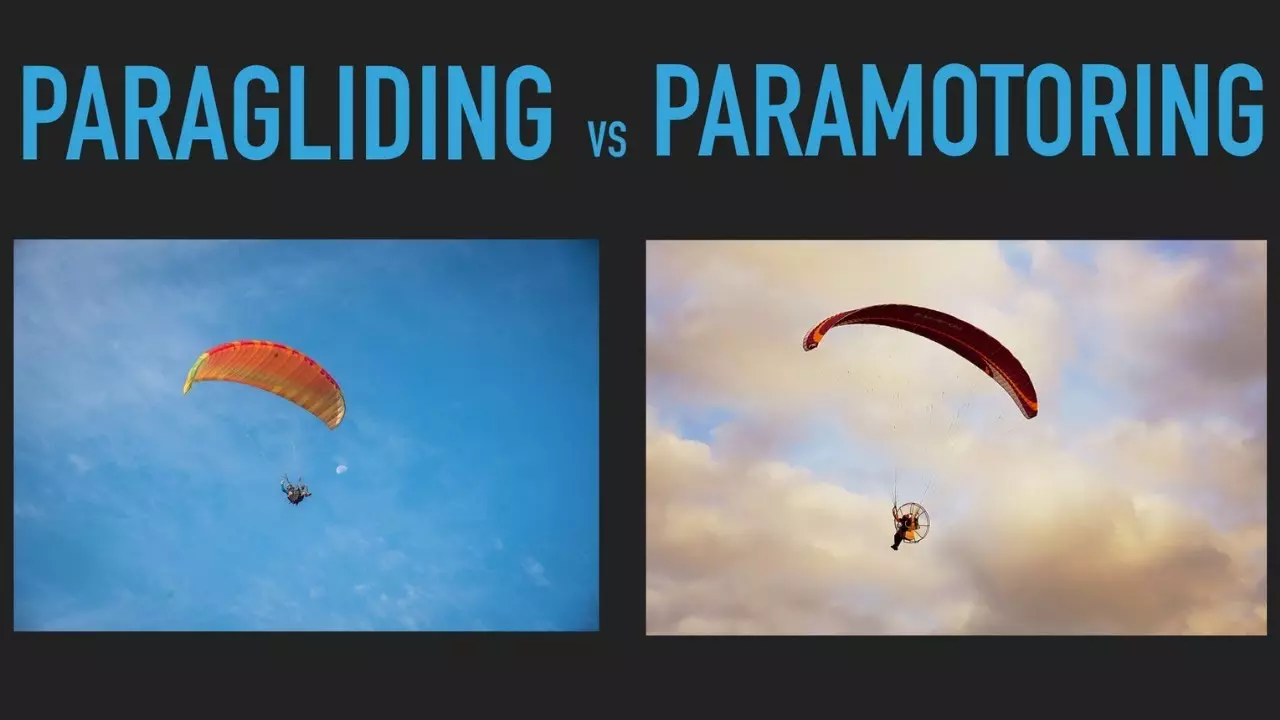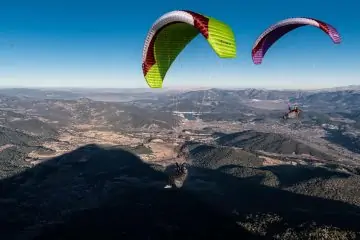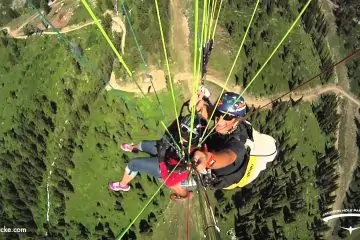As an Amazon Associate, I earn from qualifying purchases.
This article from the teamkathycarter website discusses the differences between Paragliding Vs Paramotoring.
Paragliding involves gliding using wind currents, while paramotoring uses a motorized engine for propulsion. Both activities offer unique experiences.
Paragliding allows you to soar like a bird, relying solely on wind and thermals for flight. On the other hand, paramotoring provides more control and flexibility, as you can take off and land anywhere with the help of a motor.
Each sport has its own appeal, attracting thrill-seekers and aviation enthusiasts worldwide. In this blog post, we will explore the key differences between paragliding and paramotoring, helping you decide which adventure suits your preferences and interests. Whether you prefer the serene gliding of paragliding or the powered excitement of paramotoring, both activities promise an unforgettable experience in the skies.

Credit: paramotorplanet.com
Soaring High: Paragliding Essentials- Paragliding Vs Paramotoring
Discover the key differences between paragliding and paramotoring, two exhilarating air sports. From the freedom of paragliding to the power of paramotoring, each offers a unique experience for thrill-seekers. Explore the essentials of both to find your perfect aerial adventure.
The Anatomy Of A Paraglider- Paragliding Vs Paramotoring
Paragliding is a thrilling adventure sport that involves flying like a bird, soaring high in the sky and experiencing the freedom of being suspended in the air. Before you take off, it’s essential to understand the anatomy of a paraglider. A typical paraglider consists of a canopy, lines, and a harness. The canopy is made of high-quality, lightweight fabric that is designed to inflate when air flows into it. The lines are connected to the canopy and the harness, and they help control the direction and speed of the paraglider. The harness is where the pilot sits, and it’s designed to distribute the weight evenly across the pilot’s body.
Weather Whispering: Reading Conditions For Flight
Reading the weather conditions is crucial before taking off on a paragliding adventure. Understanding the weather patterns and how they affect the air currents can make the difference between a successful flight and a disastrous one. Wind direction, speed, and temperature are three important factors that pilots consider before taking off. Wind speed and direction can affect the takeoff and landing, while temperature can affect the stability of the air currents. Other weather conditions to consider include cloud cover, humidity, and precipitation.
In conclusion, paragliding is an exciting adventure sport that requires skill, knowledge, and proper equipment. Understanding the anatomy of a paraglider and reading the weather conditions are two essential elements that every pilot must master. With the right skills and knowledge, paragliding can be a safe and exhilarating experience that you will never forget.

Credit: m.youtube.com
Propelling Forward: Paramotoring Gear- Paragliding Vs Paramotoring
When it comes to propelling forward in the skies, the gear you choose plays a crucial role. Let’s delve into the world of paramotoring gear, exploring the mechanics of a paramotor and the essential equipment every pilot should have.
Paramotor Mechanics: How It Works
A paramotor operates by harnessing the power of a motor attached to a paragliding wing. The motor generates thrust, allowing the pilot to take off and maintain altitude during flight.
The Pilot’s Backpack: Essential Equipment
- A paramotor wing: Provides lift and control during flight.
- A paramotor frame: Supports the motor and connects to the wing.
- A rescue parachute: A crucial safety device in case of emergencies.
- A throttle: Controls the motor’s speed and power output.
- A helmet: Protects the pilot’s head during takeoff, flight, and landing.
- Communication devices: Ensure communication with ground support and other pilots.
Taking The Leap: Learning To Paraglide
Finding A Flight School- Paragliding Vs Paramotoring
When considering learning to paraglide, finding a reputable flight school is crucial. Look for a school with certified instructors and a strong safety record. Research online reviews and ask for recommendations to ensure a positive learning experience.
The Journey From Groundwork To First Flight
Learning to paraglide involves a progression from ground training to finally taking flight. Groundwork includes learning about equipment, weather conditions, and safety protocols. As skills develop, students will practice launching, controlling the wing, and landing. Eventually, students will have the opportunity to experience the thrill of their first solo flight.

Credit: www.freedom-parapente.fr
Revving Up: Mastering Paramotoring- Paragliding Vs Paramotoring
Training And Certification- Paragliding Vs Paramotoring
Before taking flight, it’s crucial to undergo thorough training and obtain proper certification. Look for reputable training programs that cover essential skills such as ground handling, launch techniques, airspace regulations, and emergency procedures. Certification is typically required to ensure that pilots are well-versed in safety protocols and operational knowledge.
Solo Takeoff: Tips For Safe Flight
When gearing up for a solo takeoff, prioritize safety by conducting a pre-flight inspection of your equipment. Ensure that the paramotor is in optimal condition, the wing is properly laid out, and the weather conditions are suitable for flying. Safety measures such as wearing a helmet, utilizing a reserve parachute, and conducting a thorough pre-flight checklist are paramount for a secure and enjoyable flight experience.
Bird’s Eye View: Experiencing The Scenery
When it comes to experiencing the world from a bird’s eye view, paragliding and paramotoring offer unique perspectives of the landscape below. Each activity provides a thrilling way to take in the natural beauty from above, but they differ in terms of the experience they offer. Let’s take a closer look at the panoramic splendor in paragliding and the exhilarating exploration of the skies with paramotoring.
Panoramic Splendor In Paragliding
Paragliding offers an unmatched sense of freedom as you soar through the air, propelled by wind currents and thermals. The experience is serene and allows for uninterrupted, awe-inspiring views of the scenery below. Imagine gently gliding through the air, feeling weightless as you marvel at the sprawling landscapes and majestic natural formations below. It’s a truly immersive experience that allows you to connect with nature in a profound way.
Exploring The Skies With Paramotoring
Paramotoring provides a unique blend of thrill and tranquility, as you navigate the skies with the aid of a motorized paraglider. This mode of flight allows for more dynamic exploration of the surroundings, as you have the ability to cover greater distances and access remote areas that might be challenging to reach through traditional paragliding. The experience is characterized by a sense of empowerment, as you take control of your flight path while reveling in the breathtaking vistas that unfold beneath you.
Risks And Rewards: Safety In The Skies- Paragliding Vs Paramotoring
When it comes to aerial adventures, paragliding and paramotoring offer thrill-seekers the chance to soar through the skies and experience the world from a breathtaking vantage point. However, along with the awe-inspiring views and adrenaline rush, these high-altitude activities come with their own set of risks and rewards. Understanding the safety considerations is crucial for anyone considering taking flight in these exhilarating pursuits.
Navigating The Risks Of High Altitude Adventures
Before embarking on any high-flying excursion, it’s essential to be aware of the potential hazards that come with paragliding and paramotoring. From unpredictable weather conditions to equipment malfunctions, there are various risks to consider. Pilots must be prepared to navigate these challenges with caution and expertise to ensure a safe and enjoyable flight experience.
Emergency Protocols And Gear- Paragliding Vs Paramotoring
When venturing into the skies, having a thorough understanding of emergency protocols and the necessary gear can make all the difference in ensuring a safe outcome. Pilots need to be equipped with the appropriate tools to handle unexpected situations, from reserve parachutes and helmets to communication devices. Additionally, comprehensive training in emergency procedures is essential for effectively managing potential crises while airborne.
Community And Culture: Social Aspects- Paragliding Vs Paramotoring
Paragliding and paramotoring are not just about the thrill of flight; they also foster vibrant communities.
Clubs And Groups For Enthusiasts
Enthusiasts can join clubs like the Paragliding Association or Paramotor Club to connect with like-minded individuals.
These groups offer training, safety guidelines, and opportunities to share experiences with fellow pilots.
Events And Competitions- Paragliding Vs Paramotoring
Annual events like the Paragliding World Cup and Paramotor Racing Championship bring together pilots from around the globe.
Competitions promote camaraderie and push participants to excel in their flying skills.
Making The Choice: Which Is Right For You?
Choosing between paragliding and paramotoring involves considering various factors such as personal preference, skill level, and desired experience. Paragliding offers a pure, serene flight experience with minimal equipment, while paramotoring provides the thrill of powered flight with greater control and the ability to take off from flat ground.
Both options have their unique appeal, catering to different tastes and objectives.
When it comes to aerial sports, paragliding and paramotoring are two of the most popular options. While both sports involve flying through the air, there are some key differences that set them apart. If you’re trying to decide between paragliding and paramotoring, it’s important to consider your personality and preferences, as well as cost and accessibility factors.
Personality And Preference In Aerial Sports
Paragliding and paramotoring require different skill sets and offer unique experiences. Paragliding is all about gliding through the air, using the wind to stay aloft and navigate. It’s a more laid-back experience, with less noise and equipment than paramotoring. On the other hand, Paramotoring involves flying with a motor strapped to your back. It’s a bit more intense, with the added adrenaline of controlling your speed and altitude with the motor. If you’re someone who loves the feeling of soaring through the air with just the wind at your back, paragliding might be the right choice for you. But if you’re looking for a more active and thrilling experience, paramotoring might be the better option.
Cost Considerations And Accessibility
Another factor to consider when choosing between paragliding and paramotoring is cost and accessibility. Paragliding typically requires less equipment and training, making it a more affordable option for many people. However, it can be harder to find good paragliding locations, and you’ll need to rely on the wind and weather conditions to ensure a good flight. On the other hand, Paramotoring requires more equipment and training, making it a bit more expensive. But with a motor to power your flight, you’ll have more control over your flight path and can fly in a wider range of conditions. Additionally, paramotoring is often easier to access, as you can take off and land from just about anywhere with enough space.
Last Word about Paragliding Vs Paramotoring
Whether you choose paragliding or paramotoring ultimately comes down to your personal preferences and priorities. Consider your budget, your desired level of activity, and the type of flying experience you’re looking for. Both sports can be incredibly fun and rewarding with the right preparation and equipment. So why not give them both a try and see which one you like best?
Frequently Asked Questions about Paragliding Vs Paramotoring
What Is Safer, Paragliding Or Paramotoring?
Paragliding and paramotoring are both safe, but paramotoring is considered slightly safer due to its use of a motor for added control.
What Is The Difference Between A Paramotor And A Paraglider?
A paramotor is a motorized paraglider, while a paraglider is a foot-launched, non-motorized glider. The key difference is the motorization aspect.
What Are The Cons Of Paragliding?
The cons of paragliding include the risk of accidents, weather dependence, and potential for expensive equipment.
Why Not To Do Paragliding?
Paragliding may not be suitable if you have health issues, fear of heights, or pregnancy. Additionally, adverse weather conditions can pose risks.
Conclusion
Ultimately, the choice between paragliding and paramotoring depends on your preferences and goals. Both activities offer unique experiences and thrills for adventure enthusiasts. Whether you prefer the freedom of paragliding or the convenience of paramotoring, both sports provide an exhilarating journey through the skies.
As an Amazon Associate, I earn from qualifying purchases.



